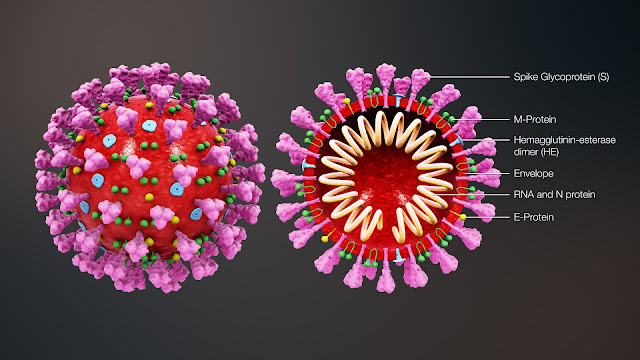
In December 2019, A pandemic, started with a pneumonia outbreak, recorded in Wuhan, China, soon the pandemic has resulted in travel restrictions and nationwide lockdowns in many countries and caused the largest global recession as it affected more than 9.76 million people around the world(ongoing). In the investigation, scientists found a novel strain of Human coronavirus(COVID-19). Later it raised many conspiracy theories such as “Chinese Biological Espionage”, “population-control project”, and “bioweapons”.
Story of Coronavirus from its origin to the pandemic, In this article, we have discussed How Coronavirus originated, and How it became pandemic? and how it raised conspiracy theories?
Contents
The name “Coronavirus” was coined by June Almeida and David Tyrrell who first observed and studied human coronaviruses, they looked more closely at the appearance of the new viruses and noticed that they had a kind of halo surrounding them. They used the Latin word corona, meaning “crown”, “halo” or “wreath”, and so the name coronavirus was born, which when viewed under two-dimensional transmission electron microscopy, refers to the characteristic of a crown or solar corona around viruses (virus particles), which appears to be covered in club-shaped protein spikes due to the surface. And the word was first used in print in 1968 by an informal group of virologists in the journal Nature to designate the new family of viruses.

In Animals:
- The most recent common parent (MRCA) of all coronaviruses is supposed to have existed as late as 8000 BCE, although some models place the common parent as far back as 55 million years or more, implying long term co-evolution with bat and avian species.
- Common parent of the all most recent coronaviruses was measured at roughly 8100 BC, and those of Alphacoronavirus roughly 2400 BC, Betacoronavirus roughly 3300 BC, Gammacoronavirus roughly 2800 BC, and Deltacoronavirus roughly 3000 BC, respectively. From the studies, it seems that, to fuel coronavirus evolution and dissemination, the warm-blooded flying vertebrates bats and birds are ideal hosts for the coronavirus gene source, bats for Alphacoronavirus, and Betacoronavirus and birds for Gammacoronavirus and Deltacoronavirus.
- The large number and global range of bat and avian species that host viruses have enabled extensive evolution and dissemination of coronaviruses.
In Humans:
- It seems that many human coronaviruses have their origin in bats. The human coronavirus NL63 shared a common parent with a bat coronavirus (ARCoV.2) between 1190 and 1449 CE. The human coronavirus 229E shared a common parent with a bat coronavirus (GhanaGrp1 Bt CoV) between 1686 and 1800 CE.
- More recently, alpaca coronavirus and human coronavirus 229E diverged sometime before 1960.
- MERS-CoV emerged in humans from bats through the median host of camels. MERS-CoV, although related to various bat coronavirus species, seems to have changed from these several centuries ago.
- The most nearly linked bat coronavirus and SARS-CoV changed in 1986.
- A possible route of evolution of SARS coronavirus and keen bat coronaviruses is that SARS-related coronaviruses co-evolved in bats for a long time. The parents of SARS-CoV first infected leaf-nose bats of the genus Hipposideridae; afterward, they spread to horseshoe bats in the species Rhinolophidae, then to Asian palm civets, and finally to humans.

Bovine coronavirus of the species Betacoronavirus 1 and subgenus Embecovirus is thought to have originated in rodents and not in bats, unlike other beta-coronaviruses. In the 1790s, equine coronavirus diverged from the bovine coronavirus after a cross-species jump. Later in the 1890s, human coronavirus OC43 diverged from bovine coronavirus after another cross-species spillover event.
It is theorized that the flu pandemic of 1890 may have been caused by this spillover event, and not by the influenza virus, because of the related timing, neurological symptoms, and unknown causative agent of the pandemic. Besides causing respiratory infections, human coronavirus OC43 is also suspected of playing a role in neurological diseases. In the 1950s, the human coronavirus OC43 began to diverge into its present genotypes. Phylogenetically, the mouse hepatitis virus (Murine coronavirus), which infects the mouse’s liver and central nervous system, is related to human coronavirus OC43 and bovine coronavirus. Human coronavirus HKU1, like the aforementioned viruses, also has its origins in rodents.
In Animals: In the 1930s when an acute respiratory infection of domesticated chickens was shown to be caused by infectious bronchitis virus (IBV), Coronaviruses were first discovered, then In the 1940s, two more animal coronaviruses, mouse hepatitis virus (MHV) and transmissible gastroenteritis virus (TGEV), were isolated.
In Humans: In the 1960s the earliest ones studied were from human patients with the common cold, which were later named human coronavirus 229E and human coronavirus OC43. Other human coronaviruses have since been identified, including SARS-CoV in 2003, HCoV NL63 in 2004, HKU1 in 2005, MERS-CoV in 2012, and SARS-CoV-2 or COVID-19 in 2019. Most of these have involved serious respiratory tract infections.
As Human coronavirus(SARS-CoV-2 or COVID-19) started with a pneumonia outbreak both inside and outside China, it also infected people who have had no direct contact with animals. That meant the virus is transmitted from one human to another. It’s now spreading around the globe, which means that people are unconsciously catching and passing on the coronavirus. This growing worldwide transmission is what is now a pandemic.
The human coronavirus(COVID-19) pandemic, started with a pneumonia outbreak, recorded in Wuhan, China, In December 2019. Late on 31 December 2019, Chinese health authorities reported to the World Health Organization (WHO) a cluster of viral pneumonia cases of unknown cause in Wuhan, Hubei, and an investigation was launched in early January 2020.
The outbreak was traced to a novel strain of coronavirus, which was given the interim name 2019-nCoV by the World Health Organization (WHO), later renamed SARS-CoV-2 by the International Committee on Taxonomy of Viruses and now also known as COVID-19. The virus that caused the outbreak is known as SARS‑CoV‑2, a newly discovered virus closely related to bat coronaviruses, pangolin coronaviruses, and SARS-CoV. The scientific consensus is that COVID-19 has a natural origin.
The Wuhan strain has been identified as a new strain of Betacoronavirus from group 2B with approximately 70% genetic similarity to the SARS-CoV. The virus has a 96% similarity to a bat coronavirus, so it is widely suspected to originate from bats as well.
Disturbing tweet from WHO
On January 14, a disturbing tweet that showed carelessness of WHO, WHO’s officially said, “Preliminary investigations conducted by the Chinese authorities have found no clear evidence of human-to-human transmission of the coronavirus.” and the same day, the Wuhan Health Commission’s public bulletin declared, “We have not found proof for human-to-human transmission.”.
By December 2019, the spread of infection was almost entirely driven by human-to-human transmission. However, at last, Human-to-human transmission was finally confirmed by the WHO and Chinese authorities by 20 January 2020.
On 30 January 2020, finally, the WHO declared the outbreak, a Public Health Emergency of International Concern (PHEIC) as 7,818 cases were confirmed globally, affecting 19 countries in five WHO regions.
On 11 March 2020, WHO acknowledged the spread of COVID-19 as a pandemic, like Italy, Iran, South Korea, and Japan reported surging cases.
Extent of infection
By December 2019, the extent of infection was almost entirely driven by human-to-human transmission. The number of coronavirus cases in Hubei continuously increased and reached 60 by 20 December and at least 266 by 31 December. On 24 December, Wuhan Central Hospital sent a bronchoalveolar lavage fluid (BAL) sample from an unsolved clinical case to sequencing company Vision Medicals. On 27 and 28 December, Vision Medicals informed the Wuhan Central Hospital and the Chinese CDC of the results of the test, showing a new coronavirus.
A pneumonia cluster of unknown causes was recognized on 26 December and treated by Dr. Zhang Jixian in Hubei Provincial Hospital, who informed the Wuhan Jianghan CDC on 27 December. On 30 December, a test report addressed to Wuhan Central Hospital, from company CapitalBio Medlab, stated an erroneous positive result for SARS, causing a group of doctors at Wuhan Central Hospital to alert their colleagues and relevant hospital authorities of the result. That evening, the Wuhan Municipal Health Commission issued a notice to various medical institutions on “the treatment of pneumonia of unknown cause”.
Eight of these doctors, including Dr. Li Wenliang, were later warned and punished by the police for spreading false rumors, and another, Ai Fen, was rebuked by her superiors for raising the alarm. Li Wenliang’s said he was almost warned everyone before the pandemic and gave earlier warnings but he was silenced by the authorities.
Enough to trigger an independent investigation when the Wuhan Municipal Health Commission made the first public announcement of a pneumonia outbreak of unknown cause on 31 December, confirming 27 cases.
The number of cases doubled approximately every seven and a half days during the early stages of the outbreak. In early and mid-January 2020, the virus spread to other Chinese provinces, because of the Chinese New Year migration, and Wuhan being a transport hub and major rail interchange. On 20 January, China reported nearly 140 new cases in one day, including two people in Beijing and one in Shenzhen.
Later official data shows that 6,174 people had already developed symptoms, and more may have been infected. A report in The Lancet on 24 January indicated human transmission, strongly recommended personal protective equipment for health workers and said testing for the virus was essential due to its “pandemic potential”. On 30 January, the WHO declared the coronavirus a public health emergency of international concern. By this time, the outbreak spread by a factor of 100 to 200 times.
On 30 January, India reported its first case of COVID-19 in Kerala, which rose to three cases by 3 February, all were students returning from Wuhan. On 31 January 2020, Italy had its first confirmed cases, two tourists from China. As of 13 March 2020, the WHO considered Europe as the active center of the pandemic. On 19 March 2020, Italy overtook China as the country with the most deaths. By 26 March, the United States had overtaken China and Italy with the highest number of confirmed cases in the world.
A study on coronavirus genomes shows the majority of COVID-19 cases in New York came from European travelers, rather than directly from China or any other Asian country.
On 11 June 2020, after 55 days without a locally transmitted case, Beijing, China reported the first COVID-19 case, followed by two more cases on 12 June. By 15 June, 79 cases were officially confirmed. Most of these patients went to Xinfadi Wholesale Market.
As of 27 June 2020, more than 9.76 million cases have been reported across 188 countries and territories, resulting in more than 492,000 deaths and more than 4.91 million people have recovered.
The virus is thought to be of zoonotic origin because several early infected had visited Huanan Seafood Wholesale Market. Some said the probable bat-to-human infection may have been among people processing bat carcasses and guano in the production of traditional Chinese medicines.
The earliest known person with symptoms was later discovered to have fallen ill on 1 December 2019, and that person did not have visible connections with the later wet market cluster. Of the early cluster of cases reported that month, two-thirds were linked with the market. On 13 March 2020, an unverified report from the South China Morning Post suggested a case traced back to 17 November 2019 (a 55-year-old from Hubei) may have been the first person infected.
However, according to some reports, the first confirmed case has been traced back to 17 November 2019, and traces of the virus have been found in wastewater that was collected from Milan and Turin on 18 December 2019. A study of the first 41 cases of confirmed COVID‑19, published in January 2020 in The Lancet, reported the earliest date of onset of symptoms as 1 December 2019. Official publications from the WHO reported the earliest onset of symptoms as 8 December 2019.
Chinese official sources said, coronavirus were mostly linked to the Huanan Seafood Wholesale Market, which also sold live animals, but In May 2020, The director of the Chinese Center for Disease Control and Prevention George Gao said, “Animal samples collected from the seafood market had tested negative for the virus, indicating that the market was the site of an early super spreading event, but it was not the site of the initial cases”.
There are several reports and theories about, where the very first case was founded. According to unpublicized news from the Chinese government, the first case can be traced back to 17 November 2019. The person was a 55-year old citizen in the Hubei province. There were four men and five women recorded to be infected in November, but none of them were initial patients.
We are still not completely sure that, where the very first case of coronavirus(COVID‑19) originated, the Chinese government hid much information and tried to cover up the initial situation. The investigation is still going on, it will be updated in this article as soon as information is received.
Conspiracy theories
Many conspiracy theories of the COVID-19 pandemic arose soon after the outbreak, recorded in Wuhan, China. Some people have claimed the virus is a bioweapon that has been accidentally or purposefully leaked from the Wuhan laboratory, some said this is a population-control project, some said it’s a result of a spy operation or the side effect of 5G upgrades to cellular networks. However, the World Health Organization has declared an “infodemic” of incorrect information about the virus, which poses risks to global health.
According to a report published in Reuters Institute for the Study of Journalism, the largest category of misinformation (39%) was “misleading or false claims about the actions or policies of public authorities, including government and international bodies like the WHO or the UN”. Read it here: Types, sources, and claims of COVID-19 misinformation
Read in detail on this topic, Main article: Dark and Conspiracy sides of Coronavirus(COVID-19) Pandemic.
Conclusion
“Coronavirus is a group of viruses that cause diseases in mammals and birds. In humans, coronaviruses cause respiratory tract infections, some of which can be fatal, such as SARS, MERS, and COVID-19. Symptoms vary among species: in chickens, they cause an upper respiratory tract disease, whereas in cows and pigs they cause diarrhea. Vaccines or antiviral drugs are not yet developed to prevent or treat human coronavirus infection, and research is ongoing on this.”
- Chinese government hid many information and tried to cover up the initial situation, They even attempt to prevent people from discovering the truth.
- Statements made by the World Health Organization, the international body that advises the world on handling health crises, often echoed China’s messages, and Misinformed at the beginning.
- Most of the countries were already not prepared for such pandemic, and maybe because of WHO Statements they didn’t take it seriously.
- New Year migration, and Wuhan being a transport hub and major rail interchange.
- Because of some irresponsible elite class.
- Irresponsible common people.
- Irresponsible religious people.
The human coronavirus(COVID-19) pandemic, started with a pneumonia outbreak, affected more than 9.76 million people around the world, and the pandemic is still ongoing. Chinese government behavior raised many questions. Statements made by the World Health Organization often echoed China’s messages, and misinformed people raised many questions. The US blamed China and China blamed the US, meanwhile, conspiracy theorists claimed many conspiracy theories. Vaccines or antiviral drugs are not yet developed to prevent or treat human coronavirus infection, and research is ongoing on this.
Sources
- de Groot RJ, Baker SC, Baric R, Enjuanes L, Gorbalenya AE, Holmes KV, Perlman S, Poon L, Rottier PJ, Talbot PJ, Woo PC, Ziebuhr J (2011). “Family Coronaviridae”. In King AM, Lefkowitz E, Adams MJ, Carstens EB, International Committee on Taxonomy of Viruses, International Union of Microbiological Societies. Virology Division (eds.). Ninth Report of the International Committee on Taxonomy of Viruses. Oxford: Elsevier. pp. 806–28. DOI:10.1016/B978-0-12-384684-6.00068-9. ISBN 978-0-12-384684-6.
- International Committee on Taxonomy of Viruses (2010-08-24). “ICTV Master Species List 2009—v10”.
- “Definition of Coronavirus by Merriam-Webster”. Merriam-Webster. Archived from the original on 2020-03-23. Retrieved 2020-05-24.
- Andersen KG, Rambaut A, Lipkin WI, Holmes EC, Garry RF (April 2020). “The proximal origin of SARS-CoV-2”. Nature Medicine. 26 (4): 450–452. DOI:10.1038/s41591-020-0820-9. PMC 7095063. PMID 32284615.
- Tyrrell DA, Fielder M (2002). Cold Wars: The Fight Against the Common Cold. Oxford University Press. p. 96. ISBN 978-0-19-263285-2.
We looked more closely at the appearance of the new viruses and noticed that they had a kind of halo surrounding them. Recourse to a dictionary produced the Latin equivalent, corona, and so the name coronavirus was born.
- Almeida JD, Berry DM, Cunningham CH, Hamre D, Hofstad MS, Mallucci L, McIntosh K, Tyrrell DA (November 1968). “Virology: Coronaviruses”. Nature. 220 (5168): 650. Bibcode:1968Natur.220..650.. DOI:10.1038/220650b0.
[T]here is also a characteristic “fringe” of projections 200 A long, which are rounded or petal-shaped … This appearance, recalling the solar corona, is shared by the mouse hepatitis virus and several viruses recently recovered from man, namely strain B814, 229E, and several others.
- Wertheim JO, Chu DK, Peiris JS, Kosakovsky Pond SL, Poon LL (June 2013). “A case for the ancient origin of coronaviruses”. Journal of Virology. 87 (12): 7039–45. DOI:10.1128/JVI.03273-12. PMC 3676139. PMID 23596293.
- Woo PC, Lau SK, Lam CS, Lau CC, Tsang AK, Lau JH, et al. (April 2012). “Discovery of seven novel Mammalian and avian coronaviruses in the genus delta coronavirus supports bat coronaviruses as the gene source of alphacoronavirus and betacoronavirus and avian coronaviruses as the gene source of gammacoronavirus and delta coronavirus“. Journal of Virology. 86 (7): 3995–4008. DOI:10.1128/JVI.06540-11. PMC 3302495. PMID 22278237.
- Forni D, Cagliani R, Clerici M, Sironi M (January 2017). “Molecular Evolution of Human Coronavirus Genomes”. Trends in Microbiology. 25 (1): 35–48. DOI:10.1016/j.tim.2016.09.001. PMC 7111218. PMID 27743750.
Specifically, all HCoVs are thought to have a bat origin, with the exception of lineage A beta-CoVs, which may have reservoirs in rodents.
- Crossley BM, Mock RE, Callison SA, Hietala SK (December 2012). “Identification and characterization of a novel alpaca respiratory coronavirus most closely related to the human coronavirus 229E”. Viruses. 4 (12): 3689–700. DOI:10.3390/v4123689. PMC 3528286. PMID 23235471.
- Forni D, Cagliani R, Clerici M, Sironi M (January 2017). “Molecular Evolution of Human Coronavirus Genomes”. Trends in Microbiology. 25 (1): 35–48. DOI:10.1016/j.tim.2016.09.001. PMC 7111218. PMID 27743750.
- Lau SK, Li KS, Tsang AK, Lam CS, Ahmed S, Chen H, et al. (August 2013). “Genetic characterization of Betacoronavirus lineage C viruses in bats reveals marked sequence divergence in the spike protein of Pipistrellus bat coronavirus HKU5 in Japanese pipistrelle: implications for the origin of the novel Middle East respiratory syndrome coronavirus“. Journal of Virology. 87 (15): 8638–50. DOI:10.1128/JVI.01055-13. PMC 3719811. PMID 23720729.
- History is repeating itself, a probable zoonotic spillover as a cause of an epidemic: the case of 2019 novel Coronavirus – Scientific Figure on ResearchGate. Available from: https://www.researchgate.net/figure/Potential-animal-origins-of-human-coronaviruses_fig1_338934614 [accessed 29 Jun, 2020]
- Vijaykrishna D, Smith GJ, Zhang JX, Peiris JS, Chen H, Guan Y (April 2007). “Evolutionary insights into the ecology of coronaviruses”. Journal of Virology. 81 (8): 4012–20. DOI:10.1128/jvi.02605-06. PMC 1866124. PMID 17267506.
- Cui J, Han N, Streicker D, Li G, Tang X, Shi Z, et al. (October 2007). “Evolutionary relationships between bat coronaviruses and their hosts”. Emerging Infectious Diseases. 13 (10): 1526–32. DOI:10.3201/eid1310.070448. PMC 2851503. PMID 18258002.
- Bidokhti MR, Tråvén M, Krishna NK, Munir M, Belák S, Alenius S, Cortey M (September 2013). “Evolutionary dynamics of bovine coronaviruses: natural selection pattern of the spike gene implies adaptive evolution of the strains”. The Journal of General Virology. 94 (Pt 9): 2036–2049. DOI:10.1099/vir.0.054940-0. PMID 23804565.
See
Table 1 - Corman VM, Muth D, Niemeyer D, Drosten C (2018). “Hosts and Sources of Endemic Human Coronaviruses”. Advances in Virus Research. 100: 163–188. DOI:10.1016/bs.aivir.2018.01.001. ISBN 9780128152010. PMC 7112090. PMID 29551135.
- Lau SK, Lee P, Tsang AK, Yip CC, Tse H, Lee RA, et al. (November 2011). “Molecular epidemiology of human coronavirus OC43 reveals the evolution of different genotypes over time and recent emergence of a novel genotype due to natural recombination”. Journal of Virology. 85 (21): 11325–37. DOI:10.1128/JVI.05512-11. PMC 3194943. PMID 21849456.
- Schaumburg CS, Held KS, Lane TE (May 2008). “Mouse hepatitis virus infection of the CNS: a model for defense, disease, and repair”. Frontiers in Bioscience. 13 (13): 4393–406. DOI:10.2741/3012. PMC 5025298. PMID 18508518.
- Bhargava, H. (2020, April 15). Coronavirus History: How did coronavirus start? Retrieved June 26, 2020, from https://www.webmd.com/lung/coronavirus-history
- Ma, Josephine (13 March 2020). “Coronavirus: China’s first confirmed Covid-19 case traced back to November 17”. South China Morning Post. Archived from the original on 13 March 2020.
- March 2020, Jeanna Bryner-Live Science Editor-in-Chief 14. “1st known case of coronavirus traced back to November in China”. livescience.com.
- Politics, Canadian (8 April 2020). “The birth of a pandemic: How COVID-19 went from Wuhan to Toronto | National Post”.
- Areddy, James T. (26 May 2020). “China Rules Out Animal Market and Lab as Coronavirus Origin”. The Wall Street Journal.
- 高昱 (26 February 2020). “独家 | 新冠病毒基因测序溯源:警报是何时拉响的” [Exclusive | Tracing the New Coronavirus gene sequencing: when did the alarm sound]. Caixin (in Chinese).
- 路子康. “最早上报疫情的她,怎样发现这种不一样的肺炎”. 中国网新闻 (in Chinese). 北京. Archived from the original on 2 March 2020.
- Hero who told the truth’: Chinese rage over coronavirus death of whistleblower doctor”. The Guardian. 7 February 2020.
- Kuo L (11 March 2020). “Coronavirus: Wuhan doctor speaks out against authorities”. The Guardian. London.
- “Undiagnosed pneumonia—China (HU): RFI”. ProMED Mail. ProMED. Retrieved 7 May 2020.
- “Archived copy” 武汉市卫健委关于当前我市肺炎疫情的情况通报. WJW.Wuhan.gov.cn (in Chinese). Wuhan Municipal Health Commission. 31 December 2019. Archived from the original on 9 January 2020.
- Li Q, Guan X, Wu P, Wang X, Zhou L, Tong Y, et al. (March 2020). “Early Transmission Dynamics in Wuhan, China, of Novel Coronavirus-Infected Pneumonia”. The New England Journal of Medicine. 382 (13): 1199–1207. DOI:10.1056/NEJMoa2001316. PMC 7121484. PMID 31995857.
- “China confirms a sharp rise in cases of SARS-like virus across the country”. 20 January 2020. Archived from the original on 20 January 2020.
- Perappadan, Bindu Shajan (4 March 2020). “COVID-19 | 6 members of Delhi patient’s family test positive for coronavirus”. The Hindu. ISSN 0971-751X.
- “Coronavirus: Primi due casi in Italia” [Coronavirus: First two cases in Italy]. Corriere Della Sera (in Italian). 31 January 2020.
- Fredericks B (13 March 2020). “WHO says Europe is the new epicenter of coronavirus pandemic”. New York Post.
- “Flattery and foot-dragging: China’s influence over the WHO under scrutiny”. The Globe and Mail Inc. 25 April 2020.
- McNeil Jr DG (26 March 2020). “The U.S. Now Leads the World in Confirmed Coronavirus Cases”. The New York Times.
- “Beijing Covid-19 outbreak puts food markets back in infection focus”. South China Morning Post. 16 June 2020. Archived from the original on 18 June 2020.
- Gan, Nectar. “China’s new coronavirus outbreak sees Beijing adopt ‘wartime’ measures”. CNN. Archived from the original on 18 June 2020.
- “COVID-19 Dashboard by the Center for Systems Science and Engineering (CSSE) at Johns Hopkins University (JHU)”. Johns Hopkins University.
- “China delayed releasing coronavirus info, frustrating WHO”. AP NEWS. 2 June 2020.












You made some first-rate points there. I regarded the web for the difficulty and found most people will go along with your website.
waterfallmagazine.com
Hi there, I discovered your site by the use of Google while searching for a comparable matter,
your site got here up, it appears to be like great.
I have bookmarked it in my google bookmarks.
Hello there, simply become alert to your blog through
Google, and found that it is truly informative. I’m gonna
be careful for brussels. I’ll be grateful if you happen to
continue this in future. Many other people will
be benefited from your writing. Cheers!
Thanks Kristopher Cheers!